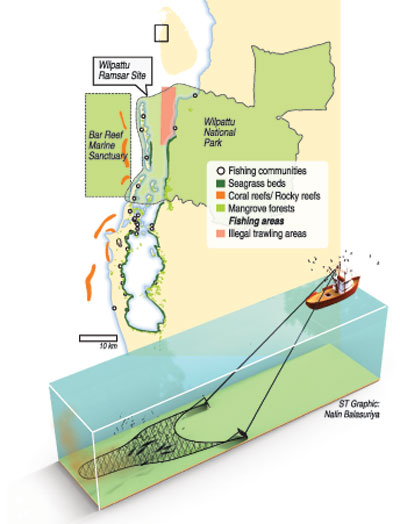News
Get on with total bottom trawling ban say conservationists
Sri Lanka passed laws to ban destructive bottom trawling in July last year but the laws are yet to be enforced and might even be watered down. Rich marine habitat is being damaged by bottom trawling in the Puttalam and Kalpitiya lagoons and in the north, including Jaffna.

Mechanised bottom trawling in broad daylight in the Puttalam lagoon
The United Small Fisheries Association (USFA) of Kalpitiya says there are 23 boats carrying out mechanised bottom trawling in the Puttalam lagoon itself. Despite being illegal the trawling occurs openly from morning till dusk, says Francis Fernando of the USFA.
Bottom trawling is trawling (towing a fishing net) along the sea floor. Two heavy metal panels are fixed at both sides of the mouth of the net to make sure it remains at the bottom of the sea floor.
This unselective, aggressive form of fishing results in the capture of many species other than the targeted fish – and largely juvenile sea life. Non-target species often constitutes more than half and as much as 80 per cent of the catch in bottom trawling for prawns, according to fisheries experts.
Sanjeewa Dinesh, a fisherman in Puttalam lagoon, lamented that the authorities act quickly against poor small-scale fishermen for using illegal types of nets but turn a blind eye to the more destructive bottom trawling that happens in broad daylight.
Fisheries Ministry officials recently stated they need time to implement the ban and that immediate stoppage of bottom trawling could affect the livelihood of practitioners. Reports say the ministry is even planning to relax the bottom-trawling ban, according to the National Aquatics Research and Development Agency (NARA).
Marine environmentalists vehemently oppose relaxing the bottom-trawling laws. “There cannot be a ‘less destructive’ bottom trawling method,” one marine biologist said, explaining that mid-water trawling was difficult to monitor. The scientists urge a total ban.
When purse seining was allowed off the northwestern coast in 2012, fishermen who were purse seining illegally through so-called “Laila nets” obtained purse seining permits.
Purse seining, which involves huge walls of net drawn tight at the base, is illegal in waters less than seven nautical miles from shore but now the nets are being used just 2km from shore, including inside the Bar Reef Marine Sanctuary. Marine environmentalists fear a similar situation may follow if the bottom trawling ban was watered down, saying monitoring is weak and there are no limits in Sri Lankan fishing.
“If the policy of no-trawling is reversed Sri Lanka will never be able to argue with India that trawling is damaging to resources and habitat so we lose one of the main factors in the argument to stop Indian trawling. Indians and Sri Lankans trawling together can be the worst situation for the resources,” fisheries expert Dr. Steve Creech argues.
He warned Sri Lanka could experience a situation similar to that faced by India. Sri Lankan bottom trawlers use similar mechanisms to that of Tamil Nadu fishing folks, the only difference being that the Lankan boats are smaller.

Bottom trawling, an unselective, aggressive form of fishing, results in the capture of many species other than the targeted fish – and largely juvenile sea life.
Dr. Creech pointed out, however, Tamil Nadu fishermen used smaller boats for bottom trawling in inshore areas, which contributed to the depletion of fisheries resources and caused Tamil Nadu fishermen to use bigger boats to go further and poach stock in Sri Lankan waters.
One excuse bottom trawlers give is that the method is best for catching prawns but Dr. Creech said small scale fisherfolk routinely used other methods to catch prawns and other bottom-dwellers. “If bottom trawling is allowed, then the small-scale fishermen will find it difficult to find enough fish. So they too will be forced to turned into illegal fishing methods in order to continue their livelihood,” Dr. Creech said.
Softening the bottom trawling ban will have other economic effects. It undermines tourism, which depends on a healthy marine environment; there is also concern for the seafood industry.
The issue also raises conservation worries: the Gulf of Mannar is one of the last areas inhabited by the endangered dugong. This marine mammal feeds on sea grasses and bottom trawling will destroy the sea grass meadows in the area.
“The law proscribing mechanised bottom trawling was published in July but sadly no action has so far been taken to implement the law,” conservation group Environmental Foundation Limited said.
Referring to the government’s concern about the “livelihood” impact of stopping illegal bottom trawling, the group said the impact on legal fishermen and the ecosystem are far greater than the ban’s effect on a small number of fishermen employed by owners of illegal bottom trawling vessels.


